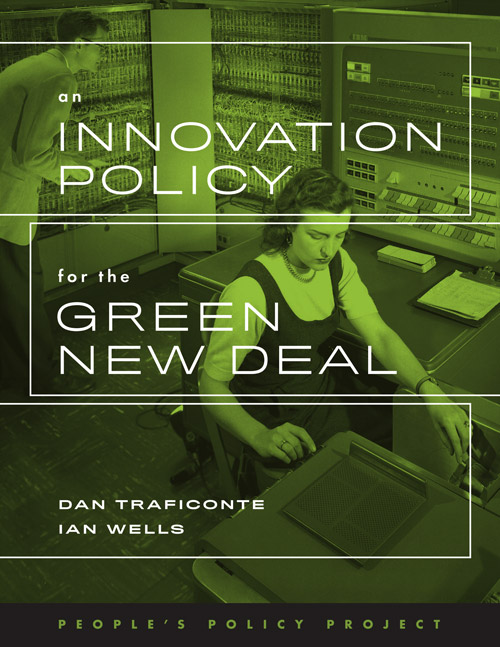Rep. Alexandria Ocasio-Cortez’s proposal for a Green New Deal is a major step forward in the fight for a green economic transition and progressive social reform. While many of the goals put forward in the proposal involve investments in infrastructure and already-existing green technologies, the Green New Deal also calls for “public investments in the research and development of new clean and renewable energy technologies and industries.” As some observers have pointed out, the Green New Deal’s R&D strategy will be the key element in bringing down the cost of low-carbon energy.
In a paper released today by the People’s Policy Project, we outline a new public R&D strategy that can help achieve a more sustainable environment and a more equitable economy. To that end, we argue that existing federal innovation programs should be scaled up significantly and reoriented to produce technology necessary for a carbon-negative economy. Additionally, we suggest changes to the existing system that would increase public ownership and control over the economic gains generated by publicly-funded innovation programs.
Since World War II, the federal government’s R&D programs have been critical to the development of many of the economy’s most transformative technologies. The Internet is one obvious example: though later developments came from the private sector, its origins lie in the Department of Defense’s ARPANET project in the late 1960s. Nearly all of the components of the iPhone, as economist Mariana Mazzucato has demonstrated, can be traced back to technology programs funded by the US government. Today, the innovation activities of the federal government include a complex array of programs, including government-run laboratories, technology development agencies, state-led industry consortia, and public venture capital funds.
From a progressive perspective, the existing federal innovation system has several problematic features. R&D is oriented overwhelmingly toward military purposes, and the direct gains from innovation tend to concentrate in particular geographic areas, many of which are already thriving. Most importantly, the current system is built on an unfair arrangement for the public: innovation programs tend to channel public investments into private hands for commercialization without direct public reimbursement. In short, the system socializes risk and privatizes gain.
An innovation policy in the service of social goals was once a major goal of American progressives. During and immediately after WWII, lawmakers from the progressive wing of the Democratic Party proposed to extend public R&D programs in keeping with New Deal policy aims. They understood technology programs as a new form of social policy, and proposed that the government should direct innovation to serve broad social goals and regional development. They also wanted the government to retain its ownership stakes over the results of these programs, since they were funded by the public in the first place. This progressive vision eventually lost out, however, to alternatives supported by conservatives in Congress and business groups, and it has never been fully revived.
The Green New Deal represents a promising opportunity to return to a progressive vision for industrial policy. Toward this end, we propose four core reforms:
- Radically scale up ARPA-E, the government’s primary program for developing early-stage green technologies, and launch a major carbon capture project within that program focused exclusively on carbon-negative technologies.
- Create a national network of Green New Deal Institutes, which can serve as industry and university consortia that, in partnership with the government, coordinate research efforts toward particular sustainable technology goals.
- Reorient the federal government’s venture capital activities toward green technology startups. The government should increase public ownership and control over these companies by placing conditions on federal financial assistance and by taking equity stakes in companies, thereby gaining leverage in corporate governance.
- Create a Green Innovation Fund for investments in green technology, financed in part by revenue from public ownership stakes in intellectual property generated by the technology programs listed above; interest from loans made to green technology firms; and returns from the government’s ownership shares in those firms.

Innovation policy has long been overlooked by the Left. This is a serious shortcoming, given the massive economic and social impact of technology development led by the government. Recently, new discussions have emerged on the Left provoking a reassessment of the viability of various forms of economic planning. The federal government’s public R&D strategy is a key example of planning that too often flies under the radar. Innovation in the US is already planned; it just isn’t planned for a green and equitable future. Innovation policy should be embraced by the Left as a key policy lever to both create new, socially-necessary technology and advance a progressive vision for the economy.
The federal government has achieved remarkable technological advances through publicly-funded R&D in previous times of national crises. Climate change is an existential threat to this country, but it is also an opportunity for the Left. In restructuring the federal government’s innovation system to meet the threat of climate change, we can also correct many of the system’s faults and adapt it to a progressive vision for the economy. We can ensure that a fair share of the gains generated by public investment are returned to the public and not hoarded in a tax haven. We can take steps to bring the public innovation system under real democratic control.
The government’s R&D capacities should play a key role in combating the threat of climate change and should be a major component of the new movement for a Green New Deal.

